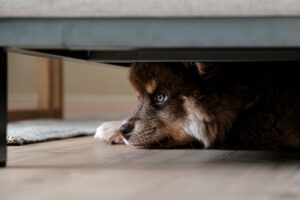Summer Sounds Can Be a Nightmare for Sensitive Dogs
While humans enjoy fireworks, parades, and parties, many dogs find summer noises overwhelming. Loud bangs, pops, and unfamiliar sounds can trigger:
- Trembling or hiding
- Excessive barking
- Pacing or restlessness
- Destructive behavior
- Attempts to escape or flee
If your dog struggles with sound sensitivity, you’re not alone — but you’re not powerless either. With preparation and training, you can dramatically reduce your dog’s stress and help them stay calm during noisy summer nights.

Why Fireworks and Summer Sounds Trigger Anxiety
Dogs have incredibly sensitive hearing. Sudden, unpredictable sounds paired with flashes of light and vibrations make fireworks particularly intense.
Other common summer triggers include:
- Thunderstorms
- Motorcycles or loud engines
- Party crowds and music
- Construction noises
The key to managing these sounds is building resilience and creating a sense of safety.
Step 1: Create a Safe, Quiet Space
Before fireworks or noisy events:
- Set up a cozy room or crate in a quiet part of the house
- Use white noise machines or calming music to buffer sound
- Close windows and draw curtains
- Add familiar blankets, chews, or toys
- Sit with your dog if it helps them remain calm, but don’t overly coddle or reinforce fearful behavior
Consistency helps your dog see this space as their “den” of safety.
Step 2: Start Desensitization Early
Use recorded firework or thunder sounds:
- Play at very low volume while your dog is calm
- Pair the sounds with treats, play, or training
- Gradually increase volume over multiple sessions
- Stop if your dog shows signs of distress and go slower next time
Desensitization helps your dog learn that these sounds don’t equal danger.
Step 3: Use Obedience to Create Focus
Structured obedience can redirect anxiety and provide clarity:
- Practice “place,” “down,” or “heel” during low-volume sound sessions
- Reward your dog for staying calm despite background noise
- Avoid comfort behaviors like petting while your dog is panicking — instead, guide them into a job (like holding “place”)
- Focus builds confidence and reduces reactive behaviors
Dogs feel more secure when they’re told what to do.
Step 4: Use Tools When Necessary
Depending on your dog’s level of anxiety, you may also consider:
- Compression shirts or anxiety wraps
- Pheromone diffusers or calming sprays
- Natural calming supplements (consult your vet)
- Temporary use of crates with covered tops
- Muzzle training (if stress leads to destructive behavior)
These tools don’t replace training but can support your efforts.
Step 5: Advocate for Your Dog During Events
If you’re attending or hosting events with fireworks or noise:
- Keep your dog on leash or in a secure crate
- Don’t leave them outside unattended
- Let guests know not to approach your dog if they’re stressed
- Exit early if needed to preserve your dog’s emotional well-being
Advocating for your dog keeps them safe and prevents regression in training.
Final Thoughts: Prevention Beats Panic
Fireworks don’t have to be a yearly trauma for your dog. With early desensitization, structured obedience, and a calm leadership approach, your dog can learn to tolerate or even ignore summer sounds.
It’s not about eliminating noise — it’s about building your dog’s ability to stay grounded when the world gets loud.
